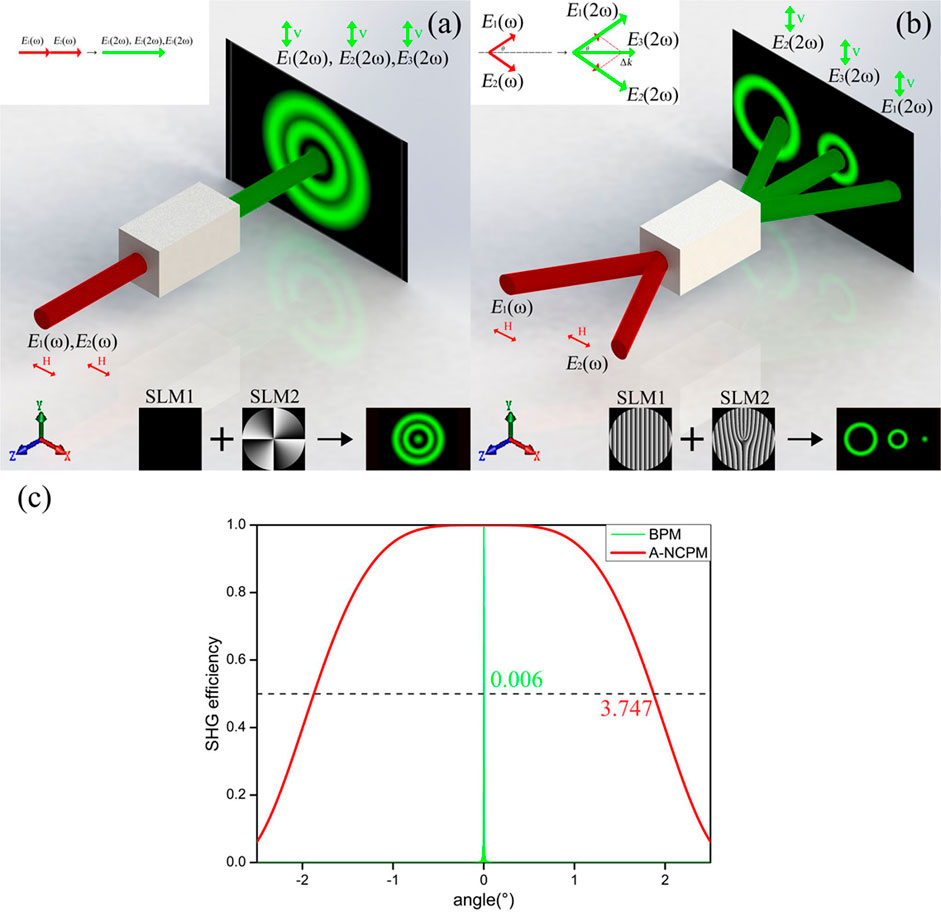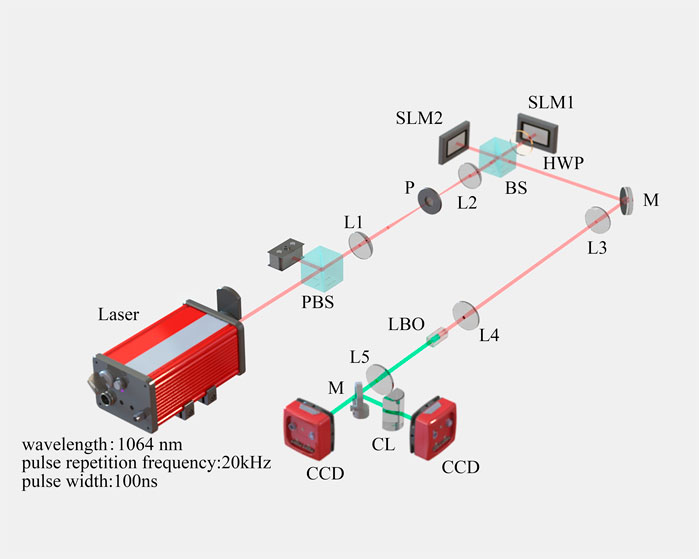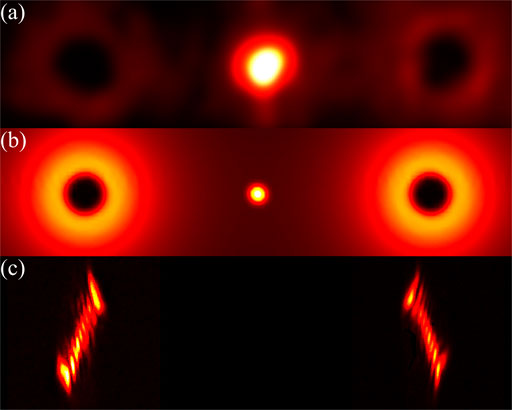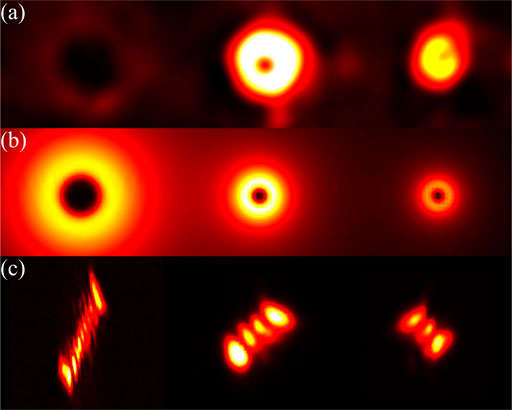Angle-Multiplexing Nonlinear Holography for Controllable Generations of Second-Harmonic Structured Light Beams
- 1National Laboratory of Solid State Microstructures, College of Engineering and Applied Sciences, School of Physics, and Collaborative Innovation Center of Advanced Microstructures, Nanjing University, Nanjing, China
- 2Department of Physics, University of Arkansas, Fayetteville, AR, United States
Nonlinear multiplexing holography emerges as a powerful tool to produce structured lights at new wavelengths. In this work, we propose and experimentally demonstrate an angle-multiplexing nonlinear holography in an angular noncritical phase-matching configuration. In experiment, various types of structured light beams, such as vortex beam, Airy beam and Airy vortex beam, are simultaneously output at second-harmonic waves along different paths. Because of the large angular acceptance bandwidth of noncritical phase-matching, one can achieve high conversion efficiency of angle-multiplexing nonlinear holography. Our method has potentially applications in high-capacity holographic storage and security encryption.
Introduction
Structured light has attracted widespread attentions because of its spatial distributions of amplitude, phase, and polarization [1]. For example, vortex beam has a unique spiral phase
Holography has many important applications in numerous areas [20–26], including data storage [20], optical encryption [21], holographic interferometry [22], microscopy [23] and dynamic holography [24–26]. Because of its powerful wavefront shaping capability, holography has recently been used in nonlinear optics to enable the generations of various structured light beams at new optical frequencies [27–34]. By utilizing the orthogonal physical dimensions of light, nonlinear holography is capable to reconstruct multiple wavefront information from a single hologram, i.e., nonlinear multiplexing holography [28, 35]. Generally, only one wavefront channel can be output at a time when the corresponding phase matching condition is satisfied in nonlinear holography. It is still difficult for nonlinear holography to output various types of structured light beams efficiently, controllably, and simultaneously.
In this paper, we propose and experimentally demonstrate an angle-multiplexing nonlinear holography in an angular noncritical phase-matching (A-NCPM) configuration. By encoding proper holograms into the fundamental waves, multiple second-harmonic (SH) beams with the desired wavefronts can be simultaneously output along different paths. High conversion efficiency is guaranteed by the large angular acceptance bandwidth of A-NCPM. In experiment, we use the angle-multiplexing nonlinear holography to generate vortex beam, Airy beam and Airy vortex beam at SH waves for example.
Methods and Experiment
We consider two fundamental fields, i.e.,
Here,
Figure 1A shows a collinear type-I BPM configuration, in which two horizontally-polarized fundamental fields propagate collinearly along the z axis. Three vertically-polarized SH fields [

FIGURE 1. Comparison of collinear and noncollinear BPM configurations. We load the holograms of a plane wave and a l = -4 vortex phase respectively on SLM1 and SLM2 for example. (A) shows the collinear BPM process, in which the generated SH fields are mixed together. (B) shows the noncollinear case by introducing an additional phase of exp(iΔk) (or exp(−iΔk)) on SLM1 (or SLM2). Clearly, the SH fields can be well separated. (C) shows the angle dependence of the normalized SHG efficiency. Here, we use 15-mm-long barium borate (BBO) crystal and lithium boric oxide (LBO) crystal for the calculations of BPM and A-NCPM processes, respectively. The acceptance angular bandwidth is 0.006° in a traditional BPM process, while it is significantly increased is 3.741° in the A-NCPM configuration. Here, we define the angular bandwidth by using the full width at half maximum (FWHM) of the curves.
This noncollinear scheme can well solve the problem of SH field overlap. However, the phase mismatch becomes
Figure 2 shows the experimental setup used in this work. In the optical alignment, the fundamental wave is derived from a 1,064 nm laser with a pulse repetition frequency of 20 kHz and a pulse width of 100 ns A polarizing beam splitter (PBS) is used to select a horizontally-polarized light. The fundamental wave is then shaped using a 4-f system consisting of two lenses (L1 and L2 with f1 = 200 mm and f2 = 75 mm) and a pinhole. After passing through a 50:50 beam splitter (BS), the fundamental wave is equally divided into two beams. These two beams are separately modulated by using two spatial light modulators (SLM1, BNS, P1920-600-1300-HDMI; and SLM2, Holoeye, Pluto-2-NIR-011) to carry the designed holograms. Because SLM1 used in the experiment only works for vertically-polarized light, we add a half-wave plate (HWP) between BS and SLM1. After modulation, they are combined via the 50:50 BS and then shaped using another 4-f system consisting of lenses L3 and L4 (with f3 = 500 mm and f4 = 50 mm). Then, the fundamental beams are incident into an LBO crystal (type-Ⅰ, θ = 0, φ = 90°, 4 × 4 × 15 mm3). A filter is placed after the LBO crystal to filter out the fundamental wave, and a lens L5 (f5 = 200 mm) is then used to perform the Fourier transform of the generated SH fields. Finally, the SH beams are recorded using a charge-coupled device (CCD) camera (Newport, LBP2-HR-VIS2). The SH vortex beams is tested by using a cylindrical lens [38].

FIGURE 2. Schematic of the experiment setup. PBS, polarization beam spitter; L, lens; P, pinhole; BS, beam splitter; HWP, half-wave plate; M, mirror; LBO, lithium boric oxide crystal; CCD, charge-coupled device; CL, cylindrical lens.
In experiment, we first demonstrate the generations of multiple SH vortex beams. First, vortex holographic phase holograms with l = −4 and l = 4 are loaded onto SLM1 and SLM2, respectively. Here, the hologram is designed according to binary computer-generated-hologram (CGH) theory [39]. Besides, a blazed grating phase is superimposed on each hologram to introduce the additional spatial phase

FIGURE 3. By using two fundamental waves of l = -4 and l = 4, three SH beams of l = -8, l = 0, and l = 8 (from left to right) are simultaneously generated. (A,B) show the experimental and simulated results, respectively. (C) shows the transformed patterns after a cylindrical lens, from which the OAM number can be measured by counting the dark strips.

FIGURE 4. By using two fundamental waves of l = -4 and l = 1, three SH beams of l = -8, l = -3, and l = 2 (from left to right) are produced at the same time. (A,B) show the experimental and simulated results, respectively. (C) shows the transformed patterns after a cylindrical lens for OAM measurements.
Next, we produce various types of spatial light beams simultaneously. In this experiment, we load the holograms for the generations of a 2D Airy beam and a l = 1 vortex beam on SLM1 and SLM2, respectively. Notably, if a fundamental Airy beam is directly frequency-doubled with itself in the nonlinear crystal, one achieves the product of two Airy beams rather than the SH Airy beam [42]. In the experiment, we use the Fourier transform (FT) of the Airy beam as the hologram on SLM1, which is imaged into the nonlinear crystal and performs SHG. Then, the generated SH field is converted to an SH Airy beam after FT through a lens. Under such experimental configuration, three different types of SH beams, i.e., SH vortex beam, SH Airy beam, and SH Airy vortex beam, are produced along different paths. The experimental results are shown in Figure 5A, which agree well with the simulated results as shown in Figure 5B. Notably, the SH intensities in Figures 3–5 are not the same because the conversion efficiencies of SHGs involving various structured light beams are different.

FIGURE 5. The experimental (A) and simulated (B) generations of Airy beam, Airy vortex beam and vortex beam (from left to right) at SH waves.
Conclusion
In conclusion, we propose an angle-multiplexing nonlinear holography to produce multiple structured light beams simultaneously under an A-NCPM configuration. In experiment, we demonstrate a three-channel output of various SH beams, which can be further extended to more output channels within the angular acceptance bandwidth of A-NCPM. The angle-multiplexing nonlinear holography can also be applied in nonlinear photonic crystals and nonlinear metasurfaces [43–47]. Our work provides a feasible solution to enhance the capacity of nonlinear holography for multi-wavelength display, multi-dimensional optical storage, optical encryption, all-optical diffractive neuron networks [48], and optical communications.
Data Availability Statement
The original contributions presented in the study are included in the article/supplementary material, further inquiries can be directed to the corresponding author.
Author Contributions
WY, CZ, TW, and PC performed the experiments under the guidance of YZ and MX, WY, and YZ wrote the manuscript with contributions from all
Funding
National Key R&D Program of China (2017YFA0303703), the National Natural Science Foundation of China (NSFC) (91950206 and 11874213), and Fundamental Research Funds for the Central Universities (021314380191 and 021314380105).
Conflict of Interest
The authors declare that the research was conducted in the absence of any commercial or financial relationships that could be construed as a potential conflict of interest.
Publisher’s Note
All claims expressed in this article are solely those of the authors and do not necessarily represent those of their affiliated organizations, or those of the publisher, the editors and the reviewers. Any product that may be evaluated in this article, or claim that may be made by its manufacturer, is not guaranteed or endorsed by the publisher.
References
1. Forbes A Structured Light from Lasers. Laser Photon Rev (2019) 13(11):1900140. doi:10.1002/lpor.201900140
2. Allen L, Beijersbergen MW, Spreeuw RJC, Woerdman JP Orbital Angular Momentum of Light and the Transformation of Laguerre-Gaussian Laser Modes. Phys Rev A (1992) 45(11):8185–9. doi:10.1103/PhysRevA.45.8185
3. Coullet P, Gil L, Rocca F Optical Vortices. Opt Commun (1989) 73(5):403–8. doi:10.1016/0030-4018(89)90180-6
4. Djordjevic IB, Arabaci M LDPC-coded Orbital Angular Momentum (OAM) Modulation for Free-Space Optical Communication. Opt Express (2010) 18(24):24722–8. doi:10.1364/OE.18.024722
5. Yan L, Gregg P, Karimi E, Rubano A, Marrucci L, Boyd R, et al. Q-plate Enabled Spectrally Diverse Orbital-Angular-Momentum Conversion for Stimulated Emission Depletion Microscopy. Optica (2015) 2(10):900–3. doi:10.1364/OPTICA.2.000900
6. Chong A, Wan C, Chen J, Zhan Q Generation of Spatiotemporal Optical Vortices with Controllable Transverse Orbital Angular Momentum. Nat Photon (2020) 14(6):350–4. doi:10.1038/s41566-020-0587-z
7. Wei D, Zhu Y, Zhong W, Cui G, Wang H, He Y, et al. Directly Generating Orbital Angular Momentum in Second-Harmonic Waves with a Spirally Poled Nonlinear Photonic crystal. Appl Phys Lett (2017) 110(26):261104. doi:10.1063/1.4990527
8. Wei D, Cheng Y, Ni R, Zhang Y, Hu X, Zhu S, et al. Generating Controllable Laguerre-Gaussian Laser Modes through Intracavity Spin-Orbital Angular Momentum Conversion of Light. Phys Rev Appl (2019) 11(1):014038. doi:10.1103/PhysRevApplied.11.014038
9. Siviloglou GA, Broky J, Dogariu A, Christodoulides DN Observation of Accelerating Airy Beams. Phys Rev Lett (2007) 99(21):213901. doi:10.1103/PhysRevLett.99.213901
10. Efremidis NK, Chen Z, Segev M, Christodoulides DN Airy Beams and Accelerating Waves: an Overview of Recent Advances. Optica (2019) 6(5):686–701. doi:10.1364/OPTICA.6.000686
11. Wei B-Y, Liu S, Chen P, Qi S-X, Zhang Y, Hu W, et al. Vortex Airy Beams Directly Generated via Liquid crystal Q-Airy-Plates. Appl Phys Lett (2018) 112(12):121101. doi:10.1063/1.5019813
12. Singh BK, Remez R, Tsur Y, Arie A Measurement of Acceleration and Orbital Angular Momentum of Airy Beam and Airy-Vortex Beam by Astigmatic Transformation. Opt Lett (2015) 40(22):5411–4. doi:10.1364/OL.40.005411
13. Zhou J, Liu Y, Ke Y, Luo H, Wen S Generation of Airy Vortex and Airy Vector Beams Based on the Modulation of Dynamic and Geometric Phases. Opt Lett (2015) 40(13):3193–6. doi:10.1364/OL.40.003193
14. Liu Y, Chen W, Tang J, Xu X, Chen P, Ma CQ, et al. Switchable Second‐Harmonic Generation of Airy Beam and Airy Vortex Beam. Adv Opt Mater. (2021) 9(4):2001776. doi:10.1002/adom.202001776
15. Dai HT, Liu YJ, Luo D, Sun XW Propagation Properties of an Optical Vortex Carried by an Airy Beam: Experimental Implementation. Opt Lett (2011) 36(9):1617–9. doi:10.1364/OL.36.001617
16. Wei B, Qi S, Liu S, Li P, Zhang Y, Han L, et al. Auto-transition of Vortex- to Vector-Airy Beams via Liquid crystal Q-Airy-Plates. Opt Express (2019) 27(13):18848–57. doi:10.1364/OE.27.018848
17. Xu C, Wu Y, Deng D Multioptical Bottles from Second-Order Chirped Symmetric Airy Vortex Beams. Opt Lett (2020) 45(13):3502–5. doi:10.1364/OL.388569
18. Hell SW, Wichmann J Breaking the Diffraction Resolution Limit by Stimulated Emission: Stimulated-Emission-Depletion Fluorescence Microscopy. Opt Lett (1994) 19(11):780–2. doi:10.1364/OL.19.000780
19. Klar TA, Hell SW Subdiffraction Resolution in Far-Field Fluorescence Microscopy. Opt Lett (1999) 24(14):954–6. doi:10.1364/OL.24.000954
20. Heanue JF, Bashaw MC, Hesselink L Volume Holographic Storage and Retrieval of Digital Data. Science (1994) 265(5173):749–52. doi:10.1126/science.265.5173.749
21. Li J, Kamin S, Zheng G, Neubrech F, Zhang S, Liu N Addressable Metasurfaces for Dynamic Holography and Optical Information Encryption. Sci Adv (2018) 4(6):eaar6768. doi:10.1126/sciadv.aar6768
22. Powell RL, Stetson KA Interferometric Vibration Analysis by Wavefront Reconstruction. J Opt Soc Am (1965) 55(12):1593–8. doi:10.1364/JOSA.55.001593
23. Gabor D Microscopy by Reconstructed Wave-Fronts. Proc R Soc Lond A (1949) 197(1051):454–87. doi:10.1098/rspa.1949.0075
24. Luc J, Bouchouit K, Czaplicki R, Fillaut J-L, Sahraoui B Study of Surface Relief Gratings on Azo Organometallic Films in Picosecond Regime. Opt Express (2008) 16(20):15633–9. doi:10.1364/OE.16.015633
25. Bartkiewicz S, Miniewicz A, Sahraoui B, Kajzar F Dynamic Charge-Carrier-Mobility-Mediated Holography in Thin Layers of Photoconducting Polymers. Appl Phys Lett (2002) 81(20):3705–7. doi:10.1063/1.1512824
26. Matczyszyn K, Bartkiewicz S, Sahraoui B A New Holographic System: Liquid crystal Doped with Photochromic Molecules. Opt Mater (2002) 20(1):57–61. doi:10.1016/S0925-3467(02)00047-2
27. Fang X, Wang H, Yang H, Ye Z, Wang Y, Zhang Y, et al. Multichannel Nonlinear Holography in a Two-Dimensional Nonlinear Photonic crystal. Phys Rev A (2020) 102(4):043506. doi:10.1103/PhysRevA.102.043506
28. Chen P, Wang C, Wei D, Hu Y, Xu X, Li J, et al. Quasi-phase-matching-division Multiplexing Holography in a Three-Dimensional Nonlinear Photonic crystal. Light Sci Appl (2021) 10(1):1–7. doi:10.1038/s41377-021-00588-5
29. Liu S, Switkowski K, Xu C, Tian J, Wang B, Lu P, et al. Nonlinear Wavefront Shaping with Optically Induced Three-Dimensional Nonlinear Photonic Crystals. Nat Commun (2019) 10(1):1–7. doi:10.1038/s41467-019-11114-y
30. Liu S, Mazur LM, Krolikowski W, Sheng Y Nonlinear Volume Holography in 3D Nonlinear Photonic Crystals. Laser Photon Rev (2020) 14(11):2000224. doi:10.1002/lpor.202000224
31. Wang H, Wei D, Xu X, Wang M, Cui G, Lu Y, et al. Controllable Generation of Second-Harmonic Vortex Beams through Nonlinear Supercell Grating. Appl Phys Lett (2018) 113(22):221101. doi:10.1063/1.5050423
32. Wei D, Wang C, Xu X, Wang H, Hu Y, Chen P, et al. Efficient Nonlinear Beam Shaping in Three-Dimensional Lithium Niobate Nonlinear Photonic Crystals. Nat Commun (2019) 10(1):1–7. doi:10.1038/s41467-019-12251-0
33. Wu Y, Liu H, Chen X Three-dimensional Nonlinear Optical Holograms. Phys Rev A (2020) 102(6):063505. doi:10.1103/PhysRevA.102.063505
34. Zhu B, Liu H, Liu Ya., Yan X, Chen Y, Chen X Second-harmonic Computer-Generated Holographic Imaging through Monolithic Lithium Niobate crystal by Femtosecond Laser Micromachining. Opt Lett (2020) 45(15):4132–5. doi:10.1364/OL.394162
35. Fang X, Yang H, Yao W, Wang T, Zhang Y, Gu M, et al. High-dimensional Orbital Angular Momentum Multiplexing Nonlinear Holography. Adv Photon (2021) 3(1):015001. doi:10.1117/1.AP.3.1.015001
36. Liu Y, Wang Z, Yu F, Qi H, Yang X, Yu X, et al. Angular Non-critical Phase-Matching Second-Harmonic-Generation Characteristics of RECOB (RE = Tm, Y, Gd, Sm, Nd and La) Crystals. Opt Express (2017) 25(10):11867–93. doi:10.1364/OE.25.011867
37. Wu FT, Zhang WZ Consideration of Angular Acceptance Angle in BBO crystal on a Highly Efficient Second Harmonic Generation. Opt Laser Tech (1998) 30(3-4):189–92. doi:10.1016/S0030-3992(98)00032-2
38. Volyar A, Bretsko M, Akimova Y, Egorov Y Measurement of the Vortex and Orbital Angular Momentum Spectra with a Single Cylindrical Lens. Appl Opt.Applied Opt (2019) 58(21):5748–55. WH. Binary computer-generated holograms1979182136613669. doi:10.1364/AO.58.005748Leedoi:10.1364/AO.18.003661
39. Lee W-H Binary Computer-Generated Holograms. Appl Opt (1979) 18(21):3661–9. doi:10.1364/AO.18.003661
40. Courtial J, Dholakia K, Allen L, Padgett MJ Second-harmonic Generation and the Conservation of Orbital Angular Momentum with High-Order Laguerre-Gaussian Modes. Phys Rev A (1997) 56(5):4193–6. doi:10.1103/PhysRevA.56.4193
41. Li Y, Zhou Z-Y, Ding D-S, Shi B-S Sum Frequency Generation with Two Orbital Angular Momentum Carrying Laser Beams. J Opt Soc Am B (2015) 32(3):407–11. doi:10.1364/AO.58.00574810.1364/josab.32.000407
42. Dolev I, Arie A Frontiers in Optics. Rochester, NY, United States: Optical Society of America (2010). p. FThA1. doi:10.1364/FIO.2010.FThA1 Second Harmonic Generation of Airy Beams in Quadratic Nonlinear Photonic Crystals.
43. Wei D, Wang C, Wang H, Hu X, Wei D, Fang X, et al. Experimental Demonstration of a Three-Dimensional Lithium Niobate Nonlinear Photonic crystal. Nat Photon (2018) 12(10):596–600. doi:10.1038/s41566-018-0240-2
44. Xu T, Switkowski K, Chen X, Liu S, Koynov K, Yu H, et al. Three-dimensional Nonlinear Photonic crystal in Ferroelectric Barium Calcium Titanate. Nat Photon (2018) 12(10):591–5. doi:10.1038/s41566-018-0225-1
45. Li G, Zhang S, Zentgraf T Nonlinear Photonic Metasurfaces. Nat Rev Mater (2017) 2(5):1–14. doi:10.1038/natrevmats.2017.10
46. Zhang Y, Sheng Y, Zhu S, Xiao M, Krolikowski W Nonlinear Photonic Crystals: from 2D to 3D. Optica (2021) 8(3):372–81. doi:10.1364/OPTICA.416619
47. Segal N, Keren-Zur S, Hendler N, Ellenbogen T Controlling Light with Metamaterial-Based Nonlinear Photonic Crystals. Nat Photon (2015) 9(3):180–4. doi:10.1038/nphoton.2015.17
Keywords: nonlinear holography, noncritical phase matching (NCPM), multiplexing, beam shaping, second harmonic generation
Citation: Yao W, Zhou C, Wang T, Chen P, Xiao M and Zhang Y (2021) Angle-Multiplexing Nonlinear Holography for Controllable Generations of Second-Harmonic Structured Light Beams. Front. Phys. 9:751860. doi: 10.3389/fphy.2021.751860
Received: 02 August 2021; Accepted: 11 October 2021;
Published: 26 October 2021.
Edited by:
Bao-Sen Shi, University of Science and Technology of China, ChinaReviewed by:
Zhi-Yuan Zhou, University of Science and Technology of China, ChinaYoussef Elkouari, University of Hassan II Casablanca, Morocco
Lixiang Chen, Xiamen University, China
Copyright © 2021 Yao, Zhou, Wang, Chen, Xiao and Zhang. This is an open-access article distributed under the terms of the Creative Commons Attribution License (CC BY). The use, distribution or reproduction in other forums is permitted, provided the original author(s) and the copyright owner(s) are credited and that the original publication in this journal is cited, in accordance with accepted academic practice. No use, distribution or reproduction is permitted which does not comply with these terms.
*Correspondence: Yong Zhang, zhangyong@nju.edu.cn
 Wenzhe Yao1
Wenzhe Yao1  Chao Zhou
Chao Zhou Yong Zhang
Yong Zhang